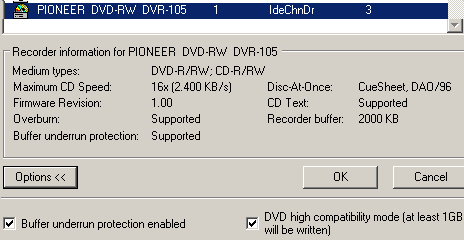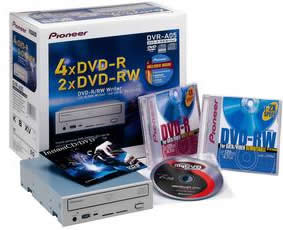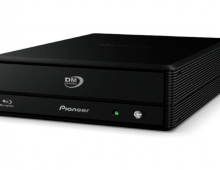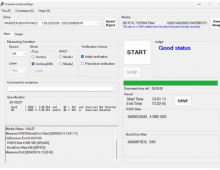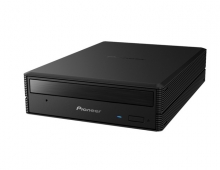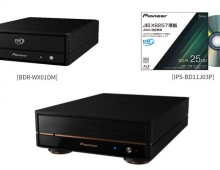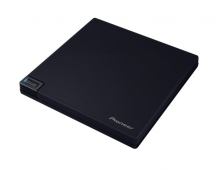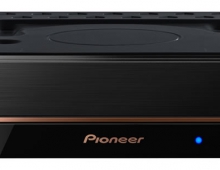Pioneer DVR-A05
1. Introduction
Pioneer DVR-A05 IDE DVD-R/-RW - Page 1
- Introduction
 Pioneer
enforces the establishment of the DVD-R/RW writers against the competition,
with the further developement of the succesfull line DVD-R/RW recorders. The
previous DVR-A04 is optimized and replaced with the new Pioneer DVR-A05, providing
advanced features, high recording speeds for both CD/DVD formats and quality
performance for the desktop user. How fast 4X DVD recording can be?
Pioneer
enforces the establishment of the DVD-R/RW writers against the competition,
with the further developement of the succesfull line DVD-R/RW recorders. The
previous DVR-A04 is optimized and replaced with the new Pioneer DVR-A05, providing
advanced features, high recording speeds for both CD/DVD formats and quality
performance for the desktop user. How fast 4X DVD recording can be?
- Important features
- Faster writing : Writing a full 4.7GB DVD-R disc can now take just 15 minutes instead of what was once an hour-long process.
Combined with the bundled software, the enhanced writing functionality includes:
- Quick Format - DVD-RW discs are ready to use in approximately two minutes, eliminating the need for the user to perform a full format of the media prior to writing
- Drag and Drop - Consumers can start writing data instantly to brand new, unformatted media with "Automatic Quick Formatting"
- Quick Finalising - Consumers are able to finalise their DVD-R/RW disc, containing less than 1GB of data, without the need for any extra lead-out writing
- Quick Grow - DVD-RW discs can now be re-opened once they have been finalised, enabling users to add extra data to utilise the disc's maximum capacity
- Multiborder - DVD-R discs can now have additional data appended once finalised, again enabling users to maximise the disc's capacity
- New high speed DVD-R/RW media
The DVD Forum has established new standards for high-speed recordable discs back in August, 2002 ( DVD-R for General Version v2.0 supports 4X speed DVD-R v1.0 and DVD-RW v1.1 supports 2X-Speed DVD-RW v1.0). Both standards are designed to cover current 1X recording capability and higher speed writing capability.(2X and 4X for DVD-R, 2X for RW). The DVD Forum is the worldwide organization made up from numerous participants who do research or engaged in DVD businesses and commit to foster the format. The official formats of the DVD Forum are the DVD-R, DVD-RW and DVD-RAM.
The previous Pioneer DVR-A03/A04 drive have issues with the new 4X DVD-R and 2X DVD-RW media. Pioneer already has released new firmware version that fixed the problem. For more information about the High Speed media issues you can visit this website. Back to the new media...
Pioneer has just shipped the first batch of the following media types and the availability for Europe will follow shortly through Pioneer distributors. The new 4X High Speed DVD-R media will come under the part number "DVS-R47BF" in a standard slim jewel case.This media also supports "CSS". Below are the pictures of the retail Pioneer 4X DVD-R media.

As Pioneer says "...Summary 4.7GB DVD-R disc corresponding to 650nm recording wavelength was developed by optimizing dye layer thickness, improving uniformity of substrate characteristics in the disc and adopting LPP structure. 61.7% modulation, 6.65% Jitter and a PIER_MAX count of 45 were observed with the disc recorded by the basic write strategy of the "DVD-R for General ver2.0" specification. Moreover, 77.1%(x2), 79.1%(x4) modulation, 6.38% (x2) ,6.42% (x4), Jitter and PIER_MAX counts of 23 (x2), and 27 (x4) were observed with the disc recorded by candidate basic write strategy of the "DVD-R for General ver2.01" specification. Therefore, the recorded discs will work on a general DVD players...". More information about 1-4X DVD-R media can be found at Pioneer's Japanese website (Japanese only).
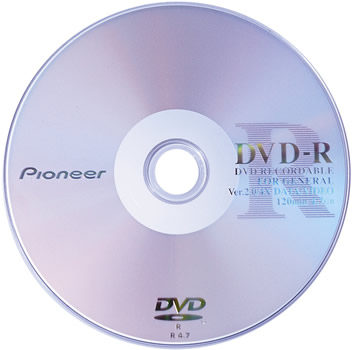
The new 2X High Speed DVD-RW media will come under the part number "DVS-RW47CF" in a standard slim jewel case. This media supports "CPRM" and "CSS". Below are the pictures of the retail Pioneer 2X DVD-RW media.
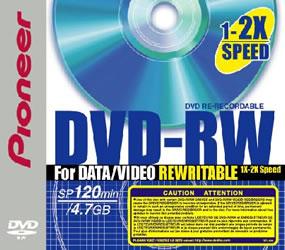
As Pioneer says "...Summary 2x recording disks which are compatible with the existing DVD-RW (Version 1.1 standard) were developed. The development process included optimization of the crystallization speed of the phase-change materials, optimization of the disk structure, optimization of the LPP shape and reduction of noises from the groove surface by means of our high precision mastering technology. These disks recorded by "basic write strategy" of the DVD Re-recordable Disc Specification Version 1.1 resulted in 7.67% jitter, 67.9% modulation, 20.9% reflectivity, and by the 2x recording optimized strategy resulted 6.92% jitter, 75% modulation and 20.1% reflectivity. From this result, it is concluded that the recorded disks both by 1X and by 2X speed will work on general DVD players...". More information about 1-2X DVD-RW media can be found at Pioneer's Japanese website (Japanese only):
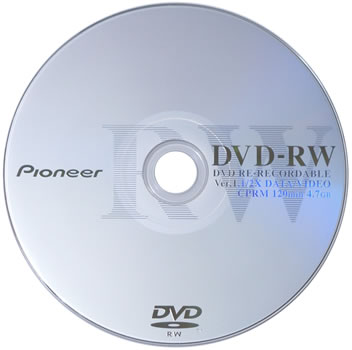
The new High Speed media will come with a warning label on its packaging, denoting the user to take care when using the disc in drives which do not support High Speed media.
- Comparison between the A05 and A04 models
Below is a table that displays the major differences between the A04 and A05 drives. With red are noted the new recording/reading speeds. As we can easily notice, the A05 is faster than the A04 drive in all recording/reading speeds.

The DVR-A05 also adopts a range of new technologies to enhance the reliability of writing to DVD:
- Liquid Crystal Tilt Technology - This technology is used in Pioneer's high-end DVD Car Navigation systems and ensures that playback and recording functions are stabilised, by using a liquid crystal tilt mechanism that maintains reliable and accurate writing or reading
- Smart Laser Driver - The advanced laser driver circuitry accurately controls the 'record signal' at increased write speeds and lessens the possibility of signal degradation
- Dynamic Resonance Absorber - This proven Pioneer technology is included within the writer to absorb vibrations caused by imbalanced discs, allowing for stable reading and writing
- Drive features
The supported writing speed for the DVD-R format are 1X, 2X and 4X CLV. The 4X speed is available only with 4X DVD-R media. For the DVD-RW fromat, the supported writing speeds are 1X and 2X CLV, again with 2X DVD-RW media. The maximum reading speed for DVD-ROM is 12X CAV for single layer and 8X CAV for dual layer discs.
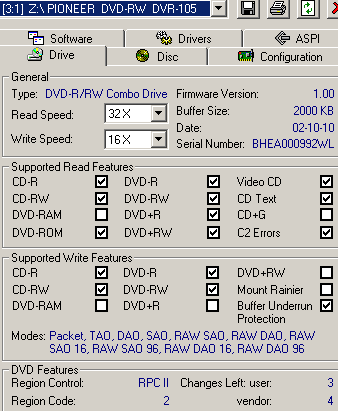
As for the CD-R media, you can select among the 4X, 8X, 12X and 16X CLV writing speeds, and 4X, 8X CLV writing for CD-RW format. The CD-ROM/-R/-RW reading speed is 32X CAV. The same speed is also supported for the CD-DA (DAE) format.
The buffer underrun protection and the 2MB cache buffer will prevent any buffer underrun problems in DVD-R/RW and CD-R/RW formats. The drive came with region Code 1 selected, and the RPCII region control allows user to change the region code 4 more times. Till now there isn't any region free firmware.
The supported disc formats are: DVD-ROM (single layer/dual layer), DVD-R (General in case of writing), DVD-RW (Ver 1.o & 1.1), CD-ROM Mode 1, CD-ROM XA Mode 2, Photo CD, CD-DA, CD-Extra, CD-R. The following writing formats are supported:
1) DVD-R: DAO, Incremental recording, multi-border recording
2) DVD-RW: Restricted overwriting
2) CD-R/RW: DAO, SAO, TAO Packet write
- The package
 The
retail package included 1 high speed DVD-R (4X) disc, 1 high speed DVD-RW (2X)
disc, and two software CD-ROM discs. The first CD-ROM contains the Sonic MyDVD
Video Suite 4 software DVD player, which comes complete with Arcsoft's "Showbiz"
video editing application and Cineplayer. In the other disc you can find the
VOB Instant CD/DVD V6.5 software complete suite, for your CD/DVD data compilations.
In addition, the package includes the usual analog audio cable, mounting screws,
the forced eject hole key and an operating instructions manual.
The
retail package included 1 high speed DVD-R (4X) disc, 1 high speed DVD-RW (2X)
disc, and two software CD-ROM discs. The first CD-ROM contains the Sonic MyDVD
Video Suite 4 software DVD player, which comes complete with Arcsoft's "Showbiz"
video editing application and Cineplayer. In the other disc you can find the
VOB Instant CD/DVD V6.5 software complete suite, for your CD/DVD data compilations.
In addition, the package includes the usual analog audio cable, mounting screws,
the forced eject hole key and an operating instructions manual.
On the disc loading tray there are the "DVD-R/RW" and the "HSRW" logos. The eject button is placed below the tray on the right side of the front panel, as usual. The indicator (Yellow Green LED) indicates the drive status. The indicator is active while reading/writing, and blinks when an error has occured. You can also find the head-phone jack, the volume control knob, the forced eject hole and a ventilation hole.

On the rear panel there are the usual connectors, such as the DC input, the ATAPI interface, the device configuration jumper, and the analog audio output. Pioneer had initially placed a cooling fan on the back of the drive, as you can see in the picture below. However, the fan was decided to be removed from the upcoming devices resulting to a much less operation noise of the drive, compared to the previous A03 and A04 models.

After removing the scews on the bottom we can see the drive's internal design. Pioneer mainly uses NEC chipsets as the following picture shows (click for a high-res)

- Installation
Pioneer DVR-A05 was identified as "Pioneer DVR-105" under WinXP. The drive was installed to the secondary IDE channel of our test PC as a "Master". The drive worked in Ultra DMA Mode 2 transfer mode. The August 2002 model came with firmware version v0.56 installed, that was used to make all the reading/writing tests. After all tests finished, a newer firmware revision was provided (v1.00) and used to re-test all the negatives.
